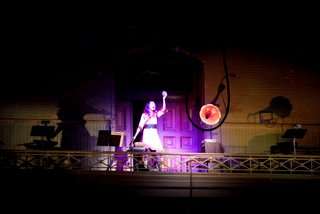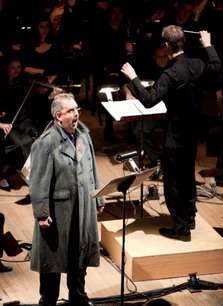|
Back
Leviathan New York
Park Avenue Armory
02/16/2011 -
Arvo Pärt: Cantus in Memory of Benjamin Britten
Paul Haas, Paul Fowler, Bora Yoon: Arco (World Premiere)
New York Polyphony: Geoffrey Williams (Countertenor), Geoffrey Silver (Tenor), Scott Dispensa (Baritone), Craig Philips (Bass), Bora Yoon (Tibetan instruments), Charles Perry Sprawls (Bass-Baritone)
Sympho (orchestra), Paul Haas (Artistic Director)
Ruth Pongstaphone (Staging and Visual Design Director), Bora Yoon (Sound Design)

B. Yoon (© James Ewing)
The first question is nomenclature. That is, how do you describe a 90-minute piece of music which fuses Oratorio, Pastiche, Cantata, Spectacular Setting, Miltonian Divisions, a Presidential Oration, Tibetan Bells, Renaissance Chanting, Epistemological Exegeses, Original Music by Three Different Composers, and a Printed Road Map which explains Section, Director, Performers, Music, and Incidental Interests?
The answer? Well…maybe…a Leviathan.
Although “Leviathan” doesn’t quite do justice to the project by composers Paul Haas, Paul Fowler and Bora Yoon, with help from Beethoven, Byrd and Perotin.
Obviously the Park Avenue Armory is one of the prime settings for epical productions. Heiner Goebbels’ Stifters Dinge, and the extraordinary Bernd Alois Zimmermann’s Die Soldaten, with its massive cast, two full orchestras, changes of settings and perspective, gave the Armory all the armor it needed to make its point.
But Arco, with all its challenges and goals, looked relatively tiny in this massive area. A 60-odd piece orchestra on the floor, a four-voiced men’s group singing William Byrd from a balcony (though New York Polyphony is an iconic quartet for all music), a bass-baritone singing from F.D.R.’s “Day of Infamy” speech, and the always wonderful Bora Yoon playing Tibetan instruments from another balcony, somehow don’t do justice to the Armory’s spaces.
Yes, Paul Haas was a good conductor, and the Sympho Orchestra sounded fine, given the resonance of the hall. (The introduction, Arvo Pärt’s Benjamin Britten Cantus depends upon notational echoes and resonances, so the Armory echoes were redundant.)
If they looked relatively Lilliputian, the goals of composers Yoon, Fowler and Haas were frankly Brobdingnagian. This daring trio’s aim was to show “A modern creation myth that speaks of the human condition…a sonic voyage through time and space…a journey in the landscape of the human soul…the struggle toward divinity and grace…”
(The entire thesis is 1,200 words, and not worth quoting further.)
Whew! Poor old J. S. Bach only wanted to praise God in his Mass and Beethoven was simply attempting to praise “joy” in his Ninth They had it easy.
But so be it, amen, and all of that. At least the music started well with the Allegretto from Beethoven’s Seventh Symphony.
How can one improve or evolve from that most tragic of all movements? With great difficulty.
Mr. Haas’ continued the movement with his own compositions (called “Building”), starting with harp and piano in a simple tune. Now the music became more complex. The strings retained Beethoven’s mournful four-note motif, but above that, various members of the orchestra walked in and out of the orchestra, the texture, with electronic effects became denser, the New York Polyphony group sung some William Byrd, winds and brass played from the balcony, and the orchestra continued to play what could only be called background music.

C.P. Sprawls (© James Ewing)
Singer Charles Perry Sprawls stood in front of the orchestra (a shame for audiences on the sides of the auditorium), and sung from F.D.R, ending with some shatteringly good falsetto notes. Then he ran into the audience and offstage. (It wasn’t out of fright, but probably part of the symbolic nature of the work.)
I see on the “road map” that Mr. Sprawls sings something called “Eyebud (3002): Must be played backwards to be understood.” , but I didn’t read my map until the following morning.
Bora Yoon also played from some Tibetan bowls which “Lead to the vinyl crackling of an 1800’s phonograph” (Sic).
Now first I must say that I was not at all bored, since I was expecting something to happen. It didn’t. The musical easel was Gargantuan, and many a nice hue (and cry) were painted. Nor, though, was I terribly involved in Arco. Frankly, with all the philosophy the literary sections (“Sorrow”, “Building”, “Aggression”, “Ecstasy”, I felt none of the above.
Had the music illustrated drama, fine. Had the grandiosity been one scintilla as inspired as Handel, Berlioz, Beethoven or even Byrd, excellent. Yet, at the end, one felt that the literary ideas were challenging, the performances superb, but in its entirety, the limbs, torso, visage and spatial sounds in the great New York Armory were a specious equivalent of body and a static if noisy vacuum replacing the “landscape of the human soul.”
CODA: Last night was the opening of the New York Armory’s four-day “Tune-In Music Festival”. The title means nothing, but the next four performances deserve noting. The opening night was fairly well packed, but some seats were available. Here is the lineup for the performances.
Thursday, Feb 17, 7.30pm: eighth blackbird etc, with music by Rzewski, Cage, Little, Weisman, Marks and Andriessen
Friday, Feb 18, 7.30pm: Argento Chamber Ensemble with music by Georg Friederich Haas, Schwitters, Bach and Steve Reich
Sunday, Feb. 20, 4.00pm: eighth blackbird etc with New York Premiere of John Luther Adams Inuksuit
Harry Rolnick
|